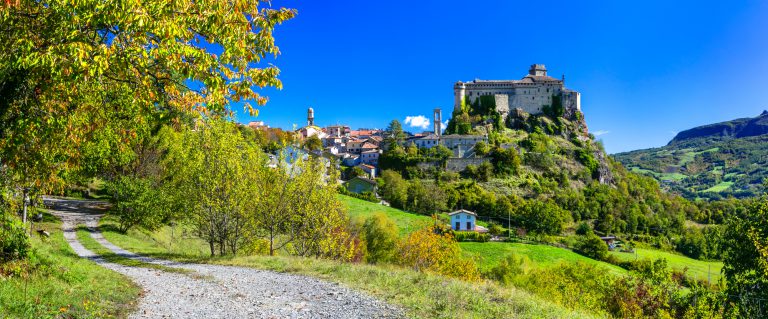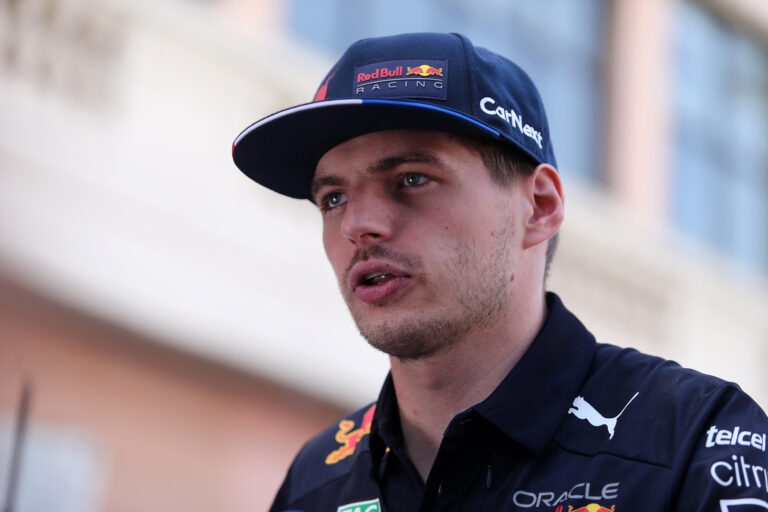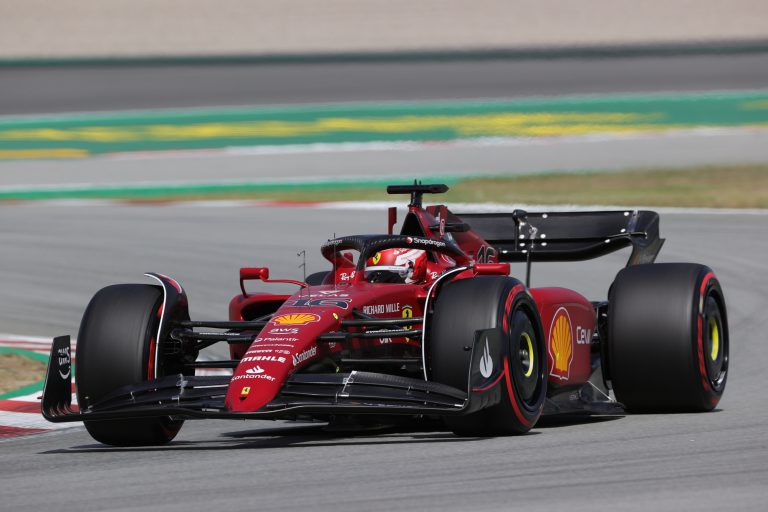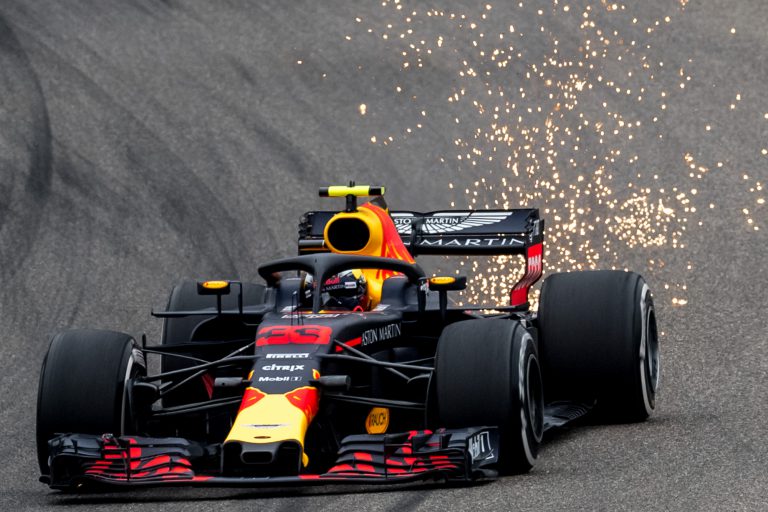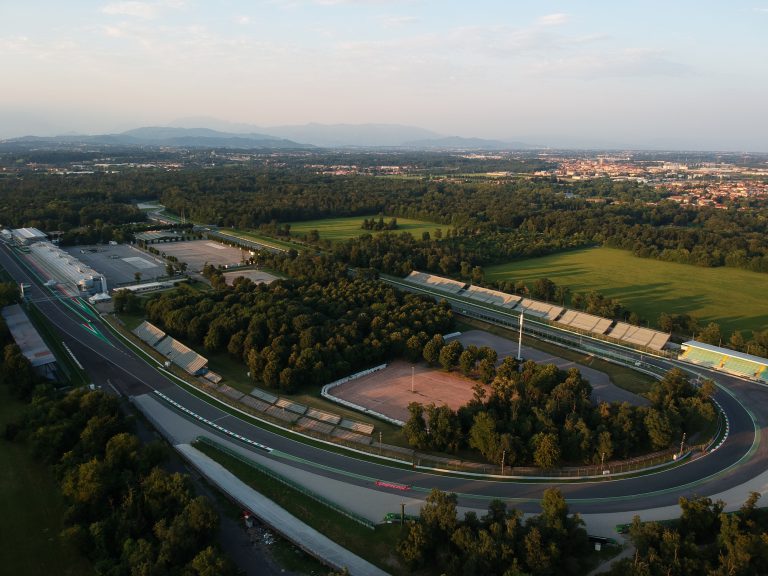History of the San Marino and Emilia Romagna Grand Prix in Formula 1

TABLE OF CONTENTS
The history of the San Marino Grand Prix and its evolution into becoming the Emilia Romagna Grand Prix is filled with amazing stories that include glory and tragedy. The Autodromo Internazionale Dino e Enzo Ferrari in the town of Imola near the city of Bologna delighted fans for nearly twenty-five years before being removed from the F1 schedule.
This infamous track made its return to the periphery when Covid-19 forced race organizers to find more circuits in Europe to deal with the global standstill caused by the virus. The Emilia Romagna Grand Prix was born and will continue to be used as long as China is unable to host its GP.
Since 2020 the races held in the home of Ferrari have been entertaining, leaving fans wondering why the circuit was ever removed. Legends of the sport have dominated the track alongside their legendary constructors bringing them to the finish line. Here is the history of the San Marino and Emilia Romagna Grand Prix.
1980’s
THE SAN MARINO GRAND PRIX
After a successful Italian Grand Prix hosted in Imola in 1980 Formula1 allowed the San Marino GP to take off in 1981. Due to F1’s rule, there could not be two races held with the moniker of the “Italian Grand Prix” therefore the race took on the name of the small state and ran under their flag. This was a mere technicality. There was no fooling anyone that this was a race in Italy, especially since Imola was and is the home of Ferrari.
IMOLA HOME OF FERRARI
In 1981 the weather was unwelcoming as it rained upon the track and for the month of May, it was rather chilly. Despite the weather, Ferrari and Gilles Villeneuve kept their partisans warm as the young Canadian took pole position on Saturday ahead of Carlos Reutemann with Williams and Rene Arnoux and his Renault.
On race day it felt like Villeneuve would be giving the Italian crowd an incredible gift as he led the race right from the start. Unfortunately, the storybook ending would not come to pass because with fourteen laps to go Villeneuve’s and Ferrari decided to run with slick tires taking them out of contention for a podium spot.
PIQUET CLAIMS THE FIRST
Brazil’s Nelson Piquet and his Brabham had Frances Didier Pironi and his Ferrari who now led the race in his sights passing the Frenchman and winning the race a couple of laps later. Pironi continued his slide down the ranks as Italy’s Ricardo Patrese and his Arrows finished in second place and Argentina’s Carlos Reutemann and his Williams finished in third. Villeneuve, who fell to the back of the back thrilled the crowd with an insane drive clawing his way backup to seventh place.
VILLENEUVE GETS ROBBED, AND FERRARI WINS JUST THE SAME
Ferrari in 1982 was hungry to win the GP in front of their home crowd but needed some luck dealing with Renault who had taken the top 2 spots in qualifying. Ferrari had their prayers answered with both the Renaults of Rene Arnoux and Alain Prost were forced to retire due to mechanical issues.
EXCHANGING LEADS
Villeneuve took the lead of the race and was on pace to win what he had lost the year before. Villeneuve’s teammate Pironi was in second place when Ferrari decided to ask the drivers to slow down to conserve their cars reliability and their track position. Pironi had plans of his own that day as he passed his teammate who listened to the team orders.
PIRONI IGNORES TEAM ORDERS
Villeneuve passed his teammate, now a rival, to take the lead again thinking that Pironi would not overtake him again. Villeneuve, with his guard down, entered the final corner of the race with the inside line open where Pironi sprinted past his teammate stealing the win.
The crowd was thrilled to have a 1-2 Ferrari finish which also had the Italian Michele Alboreto finish in third with Tyrell. It was an all-Italian podium in Italy so one can imagine the emotions in the stands. Villeneuve, on the other hand, was furious.
THE FRENCH REVOLUTION
Ferrari came back to Imola strong in 1983, taking pole position with Rene Arnoux behind the wheel. Yet it would be his French teammate Patrick Tambay who would rue the day giving Ferrari’s last win at the circuit for sixteen years.
The victory almost did not happen because Italian Ricardo Patrese was leading the race comfortably on lap 54 when he spun off crashing due to personal error. Ferrari took advantage of the matter giving fans something to cheer about again.
The podium had three drivers from France standing on it with Tambay in first, Alain Prost in second, and Arnoux in third. It is the only time in F1 history that the same flag has been raised for the three drivers on the winner’s podium.
PROST ENJOYS THE ITALIAN COUNTRYSIDE
Ferrari aimed for its third win in a row at the GP but didn’t seem likely due to the team’s poor qualifying leaving Arnoux in sixth and Alboreto in thirteenth. Nelson Piquet had pole position and led the race only to bow out on lap 48 with a turbo failure.
Alain Prost, now driving in McLaren, kept the other streak going becoming the third different driver from France to win the race in 1984. Ferrari fell short of the top of the podium finishing in second place and once again another Italian Elio de Angelis finished in third.
PUSHING FOR THE FINISH LINE
De Angelis and two other drivers didn’t even cross the finish line because they ran out of fuel, lucky for him that the other drivers were lapped, and the vast majority of the other drivers had retired from the race.
OUT OF FUEL?
When you watch motor racing you want to see speed and overtaking but in 1985 the San Marino GP was all about fuel. Formula 1 had strict rules on how much fuel can be used during the race and played a crucial part in determining the winner of the race.
Ayrton Senna claimed the first of seven consecutive pole positions in Imola only to lose his first win in Italy on lap 57 because he ran out of fuel. Ferrari thought their Swedish driver Stefan Johansson would win but he ran out of fuel too.
Nelson Piquet, Martin Brundle, and Derek Warwick suffered from the same fate with bone dry fuel tanks. Alain Prost seemingly won the race after numerous retirements only to be disqualified later because his car was deemed underweight.
AN ITALIAN WINS IN ITALY
His disqualification allowed Elio de Angelis to win his second F1 GP driving with Lotus. Belgium’s Thierry Boutsen finished in second place and Frances Patrick Tambay finished in third with both drivers pushing their cars over the finish line. Both had no more fuel and luckily for them, they were not too far from the finish line.
PROST ASKS FOR SECONDS
In 1986 Senna took pole position and once again he was snake-bitten eleven laps in. He was forced out of the race due to wheel bearing issues. Alain Prost had no problem taking control of the race until the final lap where once again fuel was precious.
Prost was forced to weave his McLaren into the final corners forcing as much fuel as possible to splash into the engine. He barely crossed the finish line to claim his second win at San Marino. Nelson Piquet, now driving for Williams, finished in second place and a young Austrian Gerhard Berger finished in third for Benetton.
SENNA GETS POLE AGAIN
The Tamburello corner in Imola had its first near-deadly crash in 1987 when Nelson Piquet slammed into the wall putting him out of the entire race weekend. Piquet, who probably had a severe concussion, battled double vision and splitting headaches for the remainder of the season.
Senna took his third straight pole position and led at the start of the race but was quickly red-flagged due to multiple stalled cars on the starting grid. The second restart of the race started well for Senna, but he could not hold off Mansel who overtook the Brazilian on lap 2. Mansell never looked back and dominated the remainder of the race.
Senna survived the remainder of the race and for the first time standing on the podium in second place for Lotus. The home crowd wasn’t left as Ferrari and Alboreto finished in third.
SENNA FINALLY WINS
Ayrton Senna by this point had mixed results in San Marino constantly claiming pole position but never adding the all-important first win. Senna, who now raced for McLaren alongside Prost was once again in prime position for a win.
Senna controlled the race right from the start, winning the race in 1988, and never had to contend with Prost whose engine stalled on some of the earlier laps causing him to fall behind. Prost had an impressive drive fighting back from eighth place to stand in second place on the podium.
Nelson Piquet continued his solid string of performances in Italy, finishing in third place after winning a tight battle with Nigel Mansell.
BERGER CRASHES AND SENNA WINS
In 1989 the Tamburello corner once again reared its ugly head as it nearly put an end to the life of Gerhard Berger. Senna, who had pole, led the race with his McLaren teammate Prost behind him followed by Ferrari and Nigel Mansell.
On lap 4 Berger who was driving for Ferrari had the ill fortune of having a mechanical failure heading into Tamburello at 290km/h slamming into the wall and having his race car catch fire. Berger was lucky to survive and the race that was red-flagged resumed thirty minutes later.
This time Senna lost the lead at the start to Prost only to retake the lead on a brilliant pass later in the lap passing the Frenchman on the inside line of the Tosa hairpin. Senna won the race without any real threat from Prost, giving him a second win in a row at the circuit. Prost added another podium finish to his name and Italian Alessandro Nannini pleased the home crowd by finishing third.
1990’s
ANOTHER ITALIAN WINS IN IMOLA
Senna looked poised to once again win in San Marino after claiming his sixth straight pole position but would be forced out early from the race due to mechanical issues. One year after nearly losing his Gerhard Berger now driving for McLaren 1990 qualified in second place and ended up redeeming himself on the track finishing in second place.
For the second time in Imola’s F1 history, an Italian won the race when Riccardo Patrese and Williams took the top spot on the podium. He wasn’t the sole Italian to be cheered that day as Nannini took his second podium finish in Imola in third place.
SEVEN POLE POSITIONS AND A THIRD VICTORY
In 1991 Senna achieved his seventh pole position in a row and for once luck would help out the Brazilian. Patrese took the lead away from Senna and led with a comfortable gap between the two until the Italian was forced out of the race on lap 17.
For once Senna was not the victim of mechanical issues in Imola, robbing him from claiming of a number of victories. Senna won his third and final race in Imola with McLaren just ahead of Gerhard Berger taking his second, second-place finish in Italy.
The surprise of the day came in the form of third place when Finland’s JJ Lehto driving in a Dallara shocked F1. It was Lehto’s first and final podium of his F1 career.
MANSELL TAKES HIS SECOND WIN
Nigel Mansell, like Ayrton Senna, suffered from terrible luck at San Marino, always competing for a podium or victory only to have it dashed by mechanical failures. In 1992 Mansell won his second GP at the Autodromo with a dominant performance that started with pole position and never relinquished the top spot crossing the finish line in first with Williams. His teammate Patrese finished in second place while Senna finished in third place with McLaren.
PROST MATCHES SENNA
Not to be outdone by his greatest rival, Alain Prost needed one more victory to tie Senna for the most wins at the San Marino GP. In 1993 Prost would match the Brazilian’s record in an entertaining race that showcased a duel between three drivers for first place.
Britain’s Damon Hill and Senna passed Prost at the start of the race who had pole placing the brit in the lead. Prost battled past Senna for second place only to lose the position he gained during a pit stop. The professor as Prost is referred to as showed his mastery of F1 overtaking both Hill and Senna for the lead at the Tosa hairpin using the backmarkers to complete the overtake.
Hill and Senna both exited the race due to mechanical issues, opening the door for a young German named Michael Schumacher to drive for Benetton to claim his first podium at the GP in second place. Martin Brundle, who is now a popular broadcaster of Formula 1, finished in third place in his Ligier.
SENNA AND RATZENBERGER FADE TO SOON
There have been many dark days in Formula 1 and in 1994 the San Marino GP certainly was one of those unpleasant days. Not one but two drivers lost their lives during the weekend, Austria’s Roland Ratzenberger and Ayrton Senna.
Rubens Barrichello also brushed with death crashing during the Friday practice at speeds of 225km, he went airborne and slammed into the top of a tire barrier. Barrichello’s car cartwheeled and momentum finally stopped when the Brazilian cars laid upside down. Barrichello was lucky to be alive and perhaps was an omen of what was to come.
QUALIFYING NIGHTMARE
During the Saturday qualifying Ratzenberger, who had a damaged front wing, could not stop his car from traveling at 314km/h heading into the Villeneuve corner straight into a wall. The Austrian cracked his skull due to the force of the impact and later died in hospital. The incident shook the rest of the drivers because they too would have to finish qualifying and race the following day with heavy hearts and doubt.
A LEGEND DIES
On race day Senna was leading the race until the Tamburello Corner ended the legend’s life. Senna was unable to keep his car on the track on the corner that requires drivers to go flat out on the throttle.
Senna, despite braking, could prevent Williams from slamming into a wall at 211km/h killing him upon impact. Sadly, Senna had an Austrian Flag in the cockpit, and it was determined that he wanted to wave it in honor of the fallen Ratzenberger at the end of the race. A terrible tragic moment that is still etched in the minds of F1 fans today.
It was the end of what could have been for one of the greatest drivers of all time. Due to the numerous crashes and loss of life that weekend, F1 made numerous changes in favor of safety. The circuit at San Marino also changed adding chicanes at Tamburello and the Villeneuve corners to slow drivers down.
THE RACE CONTINUED
Incredibly the race continued, and Michael Schumacher won his first San Marino GP with Benetton. Ferrari and Italian Nicola Larini finished in his only F1 podium in second place and Finland’s Mika Hakkinen scored his second F1 podium in third place with McLaren.
IMOLA CHANGES
One year after the horrific weekend in Imola, the San Marino GP presented the changes to the track to slow drivers down with the hopes of avoiding any more dangerous accidents in 1995. With Senna gone Hill took over as the lead driver at Williams and his rivalry with Schumacher would begin to heat up.
HILL NETS ONE
Schumacher took pole position and was primed to take his second win in a row at the GP. Before the race began a moment of silence was taken to honor Ratzenberger and Senna with rain falling which was quite fitting for the circumstances. Schumacher would lead only ten laps of the race before car problems forced him into a wall and out of the race.
Ferrari and Berger took the lead with Hill and Jean Alesi not far behind him. Berger lost his lead when his car stalled during his pit stop. Hill took over the lead and nearly lost it in his own pit stop where the fuel hose got stuck, costing him precious time but not enough to lose his leadership position. Hill took his first win in San Marino followed by the two Ferrari’s of Alesi in second and Berger in third.
HILL NETS TWO
In 1996 Damon and the powerful Williams returned to Italy hoping to repeat their performance from the previous year. Michael Schumacher left Benetton for Ferrari and instantly became a fan favorite in Imola. Schumacher added his second consecutive pole position at the circuit only to lose the top spot to the much stronger Williams of Hill.
Hill won his second and final race at the San Marino GP and was on his way to claiming his first and only driver’s title by the season’s end. Schumacher finished in second place followed by Berger who now drove for Benetton. Berger may not have won in Imola, but he certainly racked up numerous podiums throughout his career.
HEINZ HERALD TAKES A BITE TOO
Hill left Williams to join Arrows in 1997, which allowed Jacques Villeneuve to take the lead role in the team alongside German Heinz-Harald Frentzen. Williams continued its dominance of F1 and the San Marino GP with Villeneuve claiming pole and Frentzen less than half a second behind him.
Frentzen went on to win the race beating out the ever-improving Ferrari’s of Schumacher who finished in second place and Great Britain’s Eddie Irvine in third. Due to gearbox issues, Villeneuve could not capitalize on his starting position exiting the race on lap 40.
MCLAREN RETURNS TO THE PODIUM
David Coulthard and Mika Hakkinen in 1998 helped bring McLaren back into the battle for the drivers and constructor’s championships. At San Marino that year, Coulthard took pole and Hakkinen followed in second place with Schumacher and Ferrari not far behind.
The race seemed to be a foregone conclusion that the Italian crowd would witness a McLaren 1-2 finish as they pulled ahead of the pack with ease. Coulthard never lost his lead but misfortune struck Hakkinen’s gearbox and was out of the race on lap 17.
Schumacher did all he could to catch Coulthard but could not catch the Scot and had to content himself with another second-place finish at the GP. Eddie Irvine included himself once again on the podium in third place.
FERRARI’S SLUMP ENDS
Schumacher had plenty of success in Imola winning a race with Benetton and finishing in second place four times up until 1999. This year’s San Marino GP was the year that Ferrari and Schumacher could experience the joy of winning on home turf in over fifteen years.
At first, the race was destined to be a repeat 1-2 finish for McLaren, but luck and strategy turned out to be the determining factors in helping Ferrari and Schumacher win the race. With both McLarens in the lead Hakkinen was once again snake bit and exited the race early this time crashing on lap 17.
Schumacher moved into second place and was able to snatch the lead from Coulthard by pitting first and quicker than his rival. Schumacher expanded his lead while claiming the fastest lap of the race as well. Coulthard finished in second place followed by Barrichello in third driving for Stewart.
SCHUMACHER REIGNS IN IMOLA
At the beginning of the new century, Schumacher assured Ferrari fans that they did not have to wait another fifteen years to win again at Imola. In 2000 Schumacher was sandwiched between two McLarens during qualifying with Hakkinen in the lead position and Coulthard in third. From the start of the race, the battle for first was clearly between the Germans and the Fin but their battle would not be resolved on the track.
Pit stop strategies once again came into place and once again Ferrari managed to reap the rewards from a better strategy than McLaren. Schumacher was able to get ahead of Hakkinen in the second round of stops, giving the German his third win in Imola. Hakkinen had to content himself with second place with his teammate Coulthard in third.
BROTHER RALF JOINS THE FUN
In 2001 Schumacher would win again but it was not Michael who would rule the day. His brother Ralf driving for Williams put a stop to his sibling’s attempt for a third consecutive win at Imola. Michael qualified in fourth behind his brother who had McLaren’s ahead of him, Coulthard in first, and Hakkinen in second.
Ralf got the best of the two McLarens with an incredible start passing the two drivers heading into turn 1. Ralf was able to maintain his lead crossing the finish line first and for the first time in history, two brothers had won the same GP in Formula 1 history. David Coulthard added another Imola podium to his repertoire finishing in second with Barrichello adding another third-place finish to his.
SCHUMACHER TAKES MORE THAN JUST THE RACE
Ferrari was a dominant force in Formula 1 again and Schumacher gave a masterclass in racing at every GP he visited. The 2002 GP in Imola was an easy 1-2 victory for La Scuderia, which had not occurred since 1982 when Pironi and Villeneuve accomplished that feat.
Schumacher won his fourth San Marino GP, passing Ayrton Senna and Alain Prost for the most wins at that circuit. Rubens Barrichello finished in second place while Ralf Schumacher joined his brother on the podium in third.
IN THEIR MOTHER’S NAME
The Schumacher brothers 2003 were faced with the difficult decision if they would race in San Marino after their mother had just died a few hours before the race. Both brothers made their mother proud and impressed F1 fans worldwide with their amazing will to endure the sorrow they were feeling. Michael qualified first and brother Ralf was only 0.014 seconds behind him in second place.
At the start of the race, Ralf passed his brother taking the lead the race, losing it later during a pit stop where Michael took over the lead. Ralf was unable to keep up with his brother and slid to fourth place by the end of the race. Kimi Raikkonen driving for McLaren made his first appearance on the podium in Imola in second place while Barrichello kept himself in the mix in third place once again.
WHY NOT MAKE IT SIX?
In 2004 Schumacher and Ferrari were the undisputed best team in Formula 1 and quite possibly one of the best of all time. Jenson Button earned his first pole position while trying to thwart Schumacher from winning his sixth San Marino GP.
Nothing would stop the German even if he was trailing at the start of the race. Schumacher eventually passed the Brit and cruised to his fourth straight win since the beginning of the season. Button had to content himself with second place driving for BAR and Colombian Juan Pablo Montoya, driving in a Williams, finished in third.
ALONSO GETS IN THE WAY
Spain’s Fernando Alonso in 2005 driving for Renault became the man who ended Ferrari’s dominance at Imola and championship wins. Alonso benefitted from Raikkonen who had pole and led for the first nine laps when he exited the race due to mechanical issues.
Alonso had no problem leading for the entire race until he had Schumacher in his mirrors hunting the Spaniard down and for twelve laps thrilled fans with an impeccable battle between the two. Alonso held on to win his first and only San Marino GP as Schumacher took his fifth-second place finish. Austria’s Alexander Wurz driving for McLaren finished in third.
LUCKY NUMBER 7 AND IMOLA SAYS “CIAO”
In the last race to be held at the San Marino GP in 2006 before returning to F1 in 2020 under the new name Emilia Romagna GP, it was fitting that Michael Schumacher won the day. In a repeat of last year’s duel between Alonso and Schumacher, it was the German who now had to fend off the Spaniard.
Despite having tyre issues Schumacher was able to keep Alonso behind, beating him by a little over two seconds at the finish line. It was Schumacher’s seventh win in Imola and twelfth podium in Imola.
Schumacher had brought back the glory to Ferrari fans and in the last race of the circuit, he did not disappoint them. Alonso finished second in his Renault while Juan Pablo Montoya finished third driving for McLaren.
2020’s
EMILIA ROMAGNA GRAND PRIX
In 2020, after fourteen years, the San Marino GP returned to Formula 1 with the new name the Emilia Romagna Grand Prix. The Covid-19 pandemic had the whole world at a standstill, but nothing could stop F1 from racing. F1 decided to have as many races inside of Europe as possible, which opened the door for Imola to return to the schedule due to the omission of the Chinese GP. There would be no fans in attendance but everyone watching on their television, tablets, and cell phones were curious to see modern F1 cars on this historic track.
NEW NAME SAME TRACK NEW WINNER
Finland’s Valtteri Bottas took the first pole position back at the Autodromo Dino Enzo Ferrari followed by Britain’s Lewis Hamilton both with Mercedes. Max Verstappen from the Netherlands and his Red Bull qualified in third.
Bottas had a good start off the line, keeping his lead for only one lap before running into some debris on the track slowing the Fin down enough to lose his lead. Verstappen who passed Hamilton at the start of the race went on the prowl for Bottas but both drivers’ plans were dashed when their pit stops were nullified by a virtual safety car giving Hamilton a free pit stop.
Hamilton took the lead and never let it go crossing the finish line and becoming the first winner of the Emilia Romagna GP. Verstappen had managed to pass Bottas placing him into second before an awry tire forced the Dutchman into the gravel and out of the race.
Bottas claimed second place on the podium followed by Australia’s Daniel Ricciardo driving for Renault in third place. Mercedes clinched their record-setting seventh consecutive constructor’s title in F1.
CHAMPIONSHIP WAR
In 2021 Formula 1 returned to Imola with the battle for the driver’s championship between Lewis Hamilton and Max Verstappen at full throttle. With Verstappen trailing Hamilton it was imperative to get this win in Italy. Hamilton would not make the task easy taking pole position and to make matters worse Verstappen’s teammate Mexico’s Sergio Perez qualified second ahead of him.
The pressure was on and Verstappen did not disappoint himself or his fans, diving into the first corner re-emerging in first place overtaking the two cars that were ahead of him. Verstappen cruised to his first win at Imola with Hamilton twenty-two seconds behind him in second place.
Britain’s Lando Norris driving for McLaren took advantage of the melee between Bottas and George Russell finishing the race in third place. After the race, Hamilton led Verstappen by a single point heading into the next race at the Portuguese Grand Prix.


